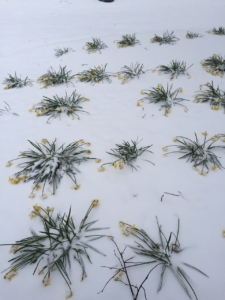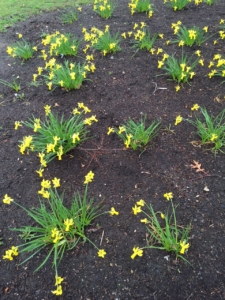By Claire Corcoran
What impact, if any, will the recent late-season snow and sudden unseasonably cold temperatures have on our trees and shrubs in Boston’s parks? It’s an interesting question with several levels to look at. Most visibly, the magnolia blooms that we enjoy each year were burned by the snow and cold temperatures that followed. If you look closely at the magnolias along Commonwealth Avenue Mall and in the Public Garden, they may have flowers, but most of them are not looking great. Many magnolias had already pushed out their flower buds and hadn’t quite opened  when the snow and cold temperatures hit them with frostbite. Magnolias are a southern species, very near the northern limit of their range here in Boston, and their flowers simply can’t withstand the cold. The emerging leaves will push off the wilted flower buds, but the trees are none the worse for it, thank goodness.
when the snow and cold temperatures hit them with frostbite. Magnolias are a southern species, very near the northern limit of their range here in Boston, and their flowers simply can’t withstand the cold. The emerging leaves will push off the wilted flower buds, but the trees are none the worse for it, thank goodness.
Many other groups of plants with more northerly ranges have more ability to withstand the cold temperatures. The cherry blossoms have flushed out like any other year, seemingly unaffected by the April snowfall and cold—though this may be more the happy result of naturally later blooming than it is a show of their New England hardiness. Many spring bulbs managed to bounce back from the snowfall impact, and make it look like it never happened. These daffodils in the Public Garden looked unhappy in the snow, but a week later they had completely bounced back. (Photos) My neighborhood Redbud (Cercis canadensis) appears to be on the brink of a record-breaking floral show – a testimony to last springs’ rainfall and snowmelt, rather than present conditions. Apples and crabapples bloom a little later in the spring, and so their flower buds weren’t impacted by the snowfall.

The late season snowfall and subsequent cold temperatures can actually help some parts of plants “wake up” after this mild winter. The dormancy of buds, those bundles of tissue that are the precursors of leaves and flowers, occurs in three phases – the pre-dormancy period in the fall, of warm days and cool nights; the deep cold of winter, and the return in the spring to warm days and cool nights that signals the end of the winter. During a mild winter season, that middle period of prolonged deep cold temperatures doesn’t really occur, leaving a muddied signal in the spring. Perhaps the plants feel a bit like we humans after a night without enough deep sleep. Plant physiologists theorize that a late season period of extreme cold, with warmer daytime temperatures, will allow dormancy in this phase to more readily break, and allow the tree to get off to a brisk start in its growing season. Also, the snowfall from the recent storm was likely a benefit to tree roots during the subsequent below freezing day, providing an insulating blanket to protect the below ground fine roots, which are actually more at risk from the cold, and more essential to the plant than its floral show.
Fortunately for the trees, and those who care for and about them, the snowfall was unlike that memorable Boston blizzard of April 1, 1997—it was far less significant in accumulation, and didn’t cause the extensive damage to trees and shrubs that that storm caused. Magnolias aside, it seems as if the snow and cold temperatures will have little lasting impact, leaving us still several weeks ahead of normal bloom times as a result of our mild winter.

